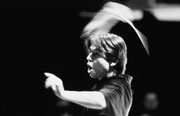IT’S UNDERSTANDABLE that the Los Angeles Philharmonic might have wanted to take a little break from Stravinsky during their Seattle appearance last week; they’d just come off a monthlong festival back home devoted to his music and were gearing up for more Stravinsky concerts in New York City last weekend, featuring The Firebird surrounded by several interesting lesser-known orchestral and chamber works.
Los Angeles Philharmonic
Benaroya Hall, March 14
Still, it was a shame not to get even a little taste of all this Stravinsky activity—the composer was a Los Angeles resident for decades, you know, and his music is a specialty of this particular orchestra and of Esa-Pekka Salonen, its conductor. I only hope they didn’t avoid Stravinsky—in favor of Ravel, Beethoven, and Salonen’s countryman Sibelius—out of misguided deference to what they feared would be the less sophisticated tastes of a provincial audience. Though I wonder: Looking at next season’s lineup for Benaroya Hall’s visiting orchestras, their programs are pretty conventional too. From the Philadelphia Orchestra, for example, arriving in October, we’ll get a stodgy program that would have been well within the comfort zone of an audience from 1910—Smetana’s The Moldau, Elgar’s Enigma Variations, and Brahms’ Fourth Symphony. Great pieces, but back-to-back?
Anyway, the Philharmonic brought a program that went from larger to smaller (in ensemble size) and smaller to larger (in intensity). Ravel’s Mother Goose Suite was delivered in ravishing pastels. The orchestra’s sound had a warm-night shimmer rather than a cooler glitter, even in the surging final climax. Sibelius’ Symphony no. 7 provided them an opportunity to show off an impressive contrast in string tone—a more sinewy sound, which when added to the mellow winds created a beautiful, organlike sonority. Their encore piece, too, was Sibelius, the “Death of M鬩sande” movement from his Pell顳 and M鬩sande suite; again we heard the same wonderfully firm presence from the strings, even at their quietest.
BEETHOVEN’S SYMPHONY NO. 7 is all about rhythm, and it was in just this area that the work lacked a bit in effect. The little rhythmic motif that pervades the first movement is notoriously difficult to play. The tendency—which I’ve heard to some extent in every concert and every recording of this work—is to making a duple rhythm out of a triple rhythm. What happens when players do this, turning a jig into a march? It don’t swing, that’s what. In the Philharmonic’s laxer than usual performance, the figure was sometimes triple, sometimes duple, and sometimes somewhere in between.
Salonen kept very, very tight control over the third and fourth movements, with the same result: They both started out with a great forward thrust, which turned into relentlessness and then rigidity by the end. A few exciting pointed-up details caught fire in the galloping finale: instruments popping out of the texture, here the second violins, there the horns, now the timpani. Salonen also heightened the tension at the beginning by adding a little extra silence to the pause between the two opening whip cracks: bum-ba-da-bum!–pause—bum-ba-da-bum! But for each of these pleasant surprises, there were other moments in the symphony that weren’t as nuanced. Wagner called Beethoven’s Seventh “the apotheosis of the dance”; this performance had a lot of thunder, but not much dancing.







